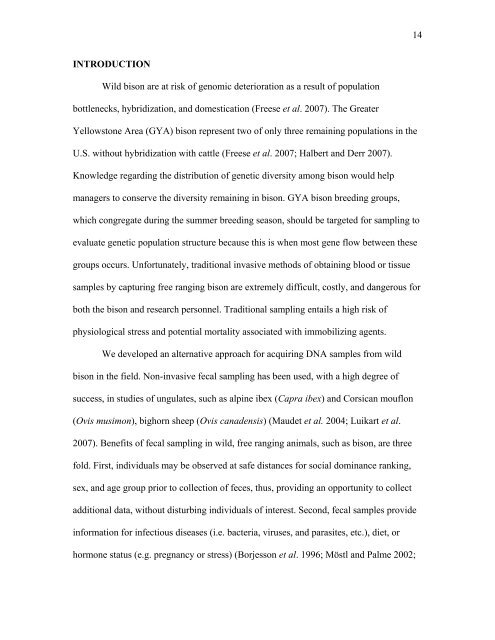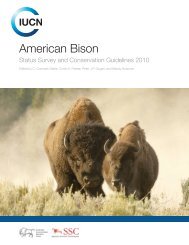Declaration Dr. Thomas H. Pringle - Buffalo Field Campaign
Declaration Dr. Thomas H. Pringle - Buffalo Field Campaign
Declaration Dr. Thomas H. Pringle - Buffalo Field Campaign
You also want an ePaper? Increase the reach of your titles
YUMPU automatically turns print PDFs into web optimized ePapers that Google loves.
INTRODUCTION<br />
Wild bison are at risk of genomic deterioration as a result of population<br />
bottlenecks, hybridization, and domestication (Freese et al. 2007). The Greater<br />
Yellowstone Area (GYA) bison represent two of only three remaining populations in the<br />
U.S. without hybridization with cattle (Freese et al. 2007; Halbert and Derr 2007).<br />
Knowledge regarding the distribution of genetic diversity among bison would help<br />
managers to conserve the diversity remaining in bison. GYA bison breeding groups,<br />
which congregate during the summer breeding season, should be targeted for sampling to<br />
evaluate genetic population structure because this is when most gene flow between these<br />
groups occurs. Unfortunately, traditional invasive methods of obtaining blood or tissue<br />
samples by capturing free ranging bison are extremely difficult, costly, and dangerous for<br />
both the bison and research personnel. Traditional sampling entails a high risk of<br />
physiological stress and potential mortality associated with immobilizing agents.<br />
We developed an alternative approach for acquiring DNA samples from wild<br />
bison in the field. Non-invasive fecal sampling has been used, with a high degree of<br />
success, in studies of ungulates, such as alpine ibex (Capra ibex) and Corsican mouflon<br />
(Ovis musimon), bighorn sheep (Ovis canadensis) (Maudet et al. 2004; Luikart et al.<br />
2007). Benefits of fecal sampling in wild, free ranging animals, such as bison, are three<br />
fold. First, individuals may be observed at safe distances for social dominance ranking,<br />
sex, and age group prior to collection of feces, thus, providing an opportunity to collect<br />
additional data, without disturbing individuals of interest. Second, fecal samples provide<br />
information for infectious diseases (i.e. bacteria, viruses, and parasites, etc.), diet, or<br />
hormone status (e.g. pregnancy or stress) (Borjesson et al. 1996; Möstl and Palme 2002;<br />
14










